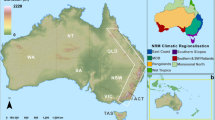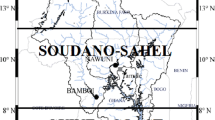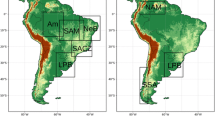Abstract
Monthly-mean precipitation, mean (TAVG), maximum (TMAX) and minimum (TMIN) surface air temperatures, and cloudiness from the CORDEX-Africa regional climate model (RCM) hindcast experiment are evaluated for model skill and systematic biases. All RCMs simulate basic climatological features of these variables reasonably, but systematic biases also occur across these models. All RCMs show higher fidelity in simulating precipitation for the west part of Africa than for the east part, and for the tropics than for northern Sahara. Interannual variation in the wet season rainfall is better simulated for the western Sahel than for the Ethiopian Highlands. RCM skill is higher for TAVG and TMAX than for TMIN, and regionally, for the subtropics than for the tropics. RCM skill in simulating cloudiness is generally lower than for precipitation or temperatures. For all variables, multi-model ensemble (ENS) generally outperforms individual models included in ENS. An overarching conclusion in this study is that some model biases vary systematically for regions, variables, and metrics, posing difficulties in defining a single representative index to measure model fidelity, especially for constructing ENS. This is an important concern in climate change impact assessment studies because most assessment models are run for specific regions/sectors with forcing data derived from model outputs. Thus, model evaluation and ENS construction must be performed separately for regions, variables, and metrics as required by specific analysis and/or assessments. Evaluations using multiple reference datasets reveal that cross-examination, quality control, and uncertainty estimates of reference data are crucial in model evaluations.










Similar content being viewed by others
References
Anderson J, Chung F, Anderson M, Brekke L, Easton D, Ejeta M, Peterson R, Snyder R (2008) Progress on incorporating climate change into management of California’s water resources. Clim Change 87:S91–S108. doi:10.1007/s10584-007-9353-1
Bader DC, Covey C, Gutowski Jr. WJ, Held IM, Kunkel KE, Miller RL, Tokmakian RT, Zhang MH (2008) Climate models: an assessment of strengths and limitations. U.S. Climate Change Science Program Synthesis and Assessment Product 3.1. Dept. of Energy, Office of Biological and Environ. Research, p 124
Baldauf M, Seifert A, Förstner J, Majewski D, Raschendorfer M, Reinhardt T (2011) Operational convective-scale numerical weather prediction with the COSMO model: description and sensitivities. Mon Wea Rev. doi:10.1175/MWR-D-10-05013.1
Boko M, Niang I, Nyong A, Vogel C, Githeko A, Medany M, Osman-Elasha B, Tabo R, Yanda P (2007) Africa. Climate change 2007: impacts, adaptation and vulnerability. In: Parry ML, Canziani OF, Palutikof JP, van der Linden PJ, Hanson CE (eds) Contribution of working group II to the fourth assessment report of the intergovernmental panel on climate change. Cambridge University Press, Cambridge, pp 433–467
Braganza K, Karoly DJ, Arblaster JM (2004) Diurnal temperature range as an index of global climate change during the twentieth century. Geophys Res Lett 31:L13217. doi:10.1029/2004GL019998
Christensen OB, Drews M, Christensen JH (2006) The HIRHAM regional climate model version 5. DMI Tech Rep 06–17:22
Christensen JH, Kjellström E, Giorgi F, Lenderink G, Rummukainen M (2010) Weight assignment in regional climate models. Clim Res 44:179–194
Coppola E, Giorgi F, Rauscher SA, Piani C (2010) Model weighting based on mesoscale structures in precipitation and temperature in an ensemble of regional climate models. Clim Res 44:121–134
Crichton DJ, Mattmann CA, Cinquini L, Braverman A, Waliser DE, Gunson M, Hart AF, Goodale CE, Lean PW, Kim J (2012) Software and architecture for sharing satellite observations with the climate modeling community. IEEE Softw 29:63–71
Déqué M (2010) Regional climate simulation with a mosaic of RCMs. Meteorol Z 19:259–266
Dosio A, Paruolo P (2011) Bias correction of the ENSEMBLES high-resolution climate change projections for use by impact models: evaluation on the present climate. J Geophys Res 116:D16106. doi:10.1029/2011JD015934
Giorgi F, Jones C, Asrar G (2009) Addressing climate information needs at the regional level: the CORDEX framework. WMO Bull 58:175–183
Gleckler PJ, Taylor KE, Doutriaux C (2008) Performance metrics for climate models. J Geophys Res 113. doi:10.1029/2007JD008972
Hart AF, Goodale CE, Mattmann CA, Zimdars P, Crichton DJ, Lean PW, Kim J, Waliser DE (2011) A cloud-enabled regional climate model evaluation system. SECLOUD’11, May 22, 2011, Honolulu, HI, USA
Hewitson B, Lennard C, Nikulin G, Jones C (2012) CORDEX-Africa: a unique opportunity for science and capacity building. CLIVAR Exchanges 60, International CLIVAR Project Office, Southampton, UK, pp 6–7
Hewitt CD (2004) Ensemble-based predictions of climate changes and their impacts. EOS 85:566
Hong S, Moon N, Lim K, Kim J (2010) Future climate change scenarios over Korea using a multi-nested downscaling system: a pilot study. Asia-Pac J Atmos Sci 46:425–435
IPCC (1995) Climate change 1995—the science of climate change. IPCC, WMO, p 572
IPCC (2001) Climate change 2001: the scientific basis. IPCC, WMO, p 881
IPCC (2007) Climate change 2007—synthesis report. Intergovernmental Panel on Climate Change, WMO, p 73
Jacob D, Bärring L, Christensen OB, Christensen JH, Hagemann S, Hirschi M, Kjellström E, Lenderink G, Rockel B, Schär C, Seneviratne SI, Somot S, van Ulden A, van den Hurk B (2007) An inter-comparison of regional climate models for Europe: design of the experiments and model performance. Clim Change 81:31–52
Jones RG, Noguer M, Hassel D, Hudson D, Wilson S, Jenkins G, Mitchell J (2004) Generating high resolution climate change scenarios using HadRM3P. Met Office Hadley Centre Rep., p 40
Jones C, Giorgi F, Asrar G (2011) The coordinated regional downscaling experiment (CORDEX). An international downscaling link to CMIP5. CLIVAR Exchanges 56, International CLIVAR Project Office, Southampton, UK, pp 34–40
Karl TR, Jones PD, Wright RW, Kukla G, Plummer N, Razuvayev V, Gallo KP, Lindseay J, Charson RJ, Peterson TC (1993) Asymmetric trend of daily minimum and maximum temperature. Bull Am Meteorol Soc 74:1007–1023
Kim J, Lee J-E (2003) A multi-year regional climate hindcast for the western U.S. using the Mesoscale Atmospheric Simulation (MAS) model. J. Hydrometeorol 4:878–890
Kim J, Kim T, Arritt RW, Miller N (2002) Impacts of increased atmospheric CO2 on the hydroclimate of the western United States. J Clim 15:1926–1942
Kirstetter P, Hong Y, Gourley JJ, Schwaller M, Petersen W, Zhang J (2012) Comparison of TRMM 2A25 Products version 6 and version 7 with NOAA/NSSL ground radar-based national mosaic QPE. J Hydrometeorol. doi:10.1175/JHM-D-12-030.1
Krishnamurti TN, Kishtawal CM, Shin DW, Williford CE (2000) Multimodel superensemble forecasts for weather and seasonal climate. J Clim 13:4196–4216
Lenderink G (2010) Exploring metrics of extreme daily precipitation in a large ensemble of regional climate model simulations. Clim Res 44:151–166
Liebmann B, Bladé I, Kiladis GN, Carvalho LMV, Senay GB, Allured D, Leroux S, Funk C (2012) Seanonality of African precipitation from 1996 to 2009. J Clim 25:4304–4322
Mearns LO, Gutowski WJ, Jones R, Leung L-Y, McGinnis S, Nunes AMB, Qian Y (2009) A regional climate change assessment program for North America. EOS, 90, No. 36, 8 Sept 2009, pp 311–312
Mearns MO, Arritt RW, Biner S, Bukovsky M, McGinnis S, Sain S, Caya D, Correia Jr. J, Flori D, Gutowski WJ, Takle ES, Jones R, Leung R, Moufouma-Okia W, McDaniel L, Nunes AMB, Qian Y, Roads JO, Sloan L, Snyder M (2012) The North American Regional Climate Change Assessment Program: overview of phase I results. Bull Am Meteorol Soc (submitted)
Meehl GA, Covey C, Delworth T, Stouffer RJ, Latif M, McAvaney B, Mitchell JF (2007) The WCRP CMIP3 multi-model dataset: a new era in climate change research. Bull Am Meteorol Soc 88:1383–1394
Meijgaard E, van Ulft LH, van den Berg WJ, Bosveld F, van den Hurk B, Lenderink G, Siebesma AP (2008) The KNMI regional atmospheric climate model RACMO, version 2.1. KNMI Tech Rep 302:43
Mitchell TD, Jones PD (2005) An improved method of constructing a database of monthly climate observations and associated high-resolution grids. Int J Climatol 25:693–712. doi:10.1002/joc.1181
Nature (2010) Validation required. Nature 463. doi:10.1038/463849a
Nikulin G, Jones C, Samuelsson P, Giorgi F, Sylla MB, Asrar G, Büchner M, Cerezo-Mota R, Christensen OB, Déqué M, Fernandez J, Hänsler A, van Meijgaard E, Sushama L (2012) Precipitation climatology in an ensemble of CORDEX-Africa regional climate simulations. J Clim. doi:10.1174/JCLI-D-11-00375.1
Overpeck JT, Meehl GA, Bony S, Easterling DR (2011) Climate data challenges in the 21st century. Science 331:700–702. doi:10.1126/science.1197869
Pal JS, Giorgi F, Bi X, Elguindi N, Solmon F, Rauscher SA, Gao X, Francisco R, Zakey A, Winter J, Ashfaq M, Syed FS, Sloan LC, Bell JL, Diffenbaugh NS, Karmacharya J, Konaré A, Martinez D, da Rocha RP, Steiner AL (2007) Regional climate modeling for the developing world: the 18 ICTP RegCM3 and RegCNET. Bull Am Meteorol Soc 88:1395–1409
Platnick E, King MD, Ackerman SA, Menzel WP, Baum BA, Riédi JC, Frey RA (2003) The MODIS cloud products: algorithms and examples from Terra. IEEE Trans Geosci Remote Sens 41:459–473
Reichler T, Kim J (2008a) How well do coupled models simulate today’s climate? Bull Am Meteorol Soc 89:303–311
Reichler T, Kim J (2008b) Uncertainties in the climate mean state of global observations, reanalyses, and the GFDL climate model. J Geophys Res 113:D05106. doi:10.1029/2007JD009278
Reitsma RF, Carron JC (1997) Object-oriented simulation and evaluation of river basin operations. J Geogr Inf Decis Anal 1:9–24
Rusticucci M, Barrucand M (2004) Observed trends and changes in temperature extremes over Argentina. J Clim 17:4099–4107
Samuelsson P, Jones CG, Willén U, Ullerstig A, Gollvik S, Hansson U, Kjellström E, Nikulin G, Wyser K (2011) The Rossby Centre regional climate model RCA3: model description and performance. Tellus A 63:4–23
Segele ZT, Lamb PJ, Leslie LM (2009) Seasonal-to-interannual variability of Ethiopia/Horn of Africa monsoon. Part I: associations of wavelet-filtered large-scale atmospheric circulation and global sea surface temperature. J Clim 22:3396–3421
Shige S, Sasaki H, Okamoto K, Iguchi T (2006) Validation of rainfall estimates from the TRMM precipitation radar and microwave imager using a radiative transfer model: 1. Comparison of the version-5 and -6 products. Geophys Res Lett 33:L13803. doi:10.1029/2006GL026350
Skamarock WC, Klemp JB, Dudhia J, Gill DO, Barker DM, Wang W, Powers JG (2008) A description of the Advanced Research WRF Version 3. NCAR Tech 15 Note NCAR/TN–475+STR, p 113
Tapiador FJ (2010) A joint estimate of the precipitation climate signal in Europe using eight regional models and five observational datasets. J Clim 23:1719–1738
Tapiador FJ, Sánchez E (2008) Changes in the European precipitation climatologies (2070–2100) as derived by eight regional climate models. J Clim 21:2540–2557
Tapiador FJ, Hou AY, de Castro M, Checa R, Cuartero F, Barros AP (2011) Precipitation estimates for hydroelectricity. Energy Environ Sci. doi:10.1039/C1EE01745D
Tapiador FJ, Turk HJ, Petersen W, Hou AY, Garcia-Ortega E, Machado LAT, Angelis CF, Salio P, Kidd C, Huffman GJ, de Castro M (2012) Global precipitation measurement: methods, datasets and applications. Atmos Res. ISSN 0169-8095
Taylor KE (2001) Summarizing multiple aspects of model performance in a single diagram. J Geophys Res 106:7183–7192
Waliser DE, Shi Z, Lanzante JR, Oort AH (1999) The Hadley circulation: assessing NCEP/NCAR reanalysis and sparse in situ estimates. Clim Dyn 15:719–735
Yoon W, Stefanova L, Mitra A, Vijaya TS, Kumar V, Dewar W, Krishnamurti T (2005) A multi-model superensemble algorithm for seasonal climate prediction using DEMETER forecasts. Tellus A 57:280–289. doi:10.1111/j.1600-0870.2005.00131.x
Zadra A, Caya D, Côté J, Dugas B, Jones C, Laprise R, Winger K, Caron L (2008) The next Canadian regional climate model. Phys Can 64:75–83
Acknowledgments
We thank Dr. Guan for the Taylor Diagrams used in this paper. This study is supported by American Recovery and Re-investment Act (ARRA), The National Aeronautics and Space Administration (NASA) National Climate Assessment (11-NCA11-0028) and AIST (AIST-QRS-12-0002) projects, and the National Science Foundation (NSF) ExArch (1125798) and EaSM (2011-67004-30224). The contribution from D. Waliser, C. Mattmann, C. Goodale, A. Hart, P. Zimdars, and D. Crichton to this study was performed on behalf of the Jet Propulsion Laboratory, California Institute of Technology, under a contract with the National Aeronautics and Space Administration.
Author information
Authors and Affiliations
Corresponding author
Electronic supplementary material
Below is the link to the electronic supplementary material.



Rights and permissions
About this article
Cite this article
Kim, J., Waliser, D.E., Mattmann, C.A. et al. Evaluation of the CORDEX-Africa multi-RCM hindcast: systematic model errors. Clim Dyn 42, 1189–1202 (2014). https://doi.org/10.1007/s00382-013-1751-7
Received:
Accepted:
Published:
Issue Date:
DOI: https://doi.org/10.1007/s00382-013-1751-7




